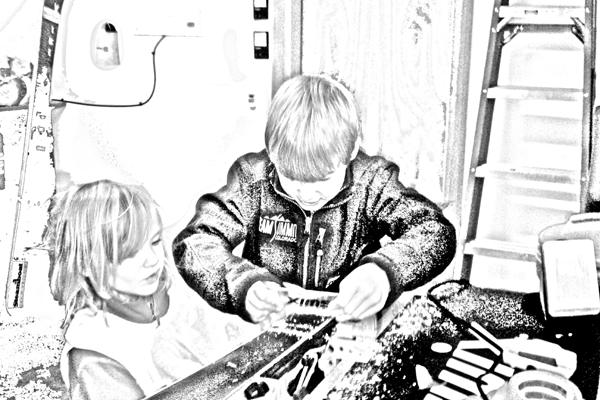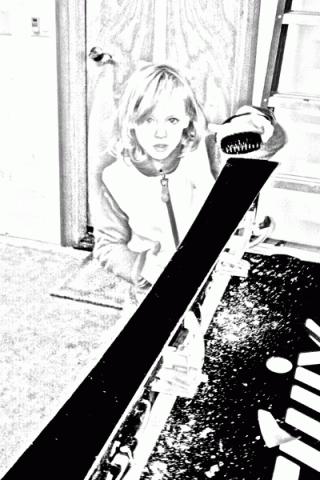
Despite this photo op, the kids did not tune their skis this season.
There is a blob of red wax on my black leather Dansko clogs. This is my fault for not wearing work boots, I suppose, but still. The wax blob represents the indignity of my new job as a ski tuner. I can now add that to my resume, which currently includes: chauffeur, social planner, chef, waitress, chamber maid, tutor, gardener, and personal shopper. My clients are completely irascible.
Now that ski season is coming to a close (for those of you who think it’s long gone, you should know that the bullwheels are still turning at A-Basin), I’m happy to put the files and brushes and iron away till next fall.
When we signed our three kids (the aforementioned clients) up for a ski racing program last fall at Copper Mountain (with Team Summit), we were told by the coaches, in no uncertain terms, that we needed to tune the kids’ skis.
To understand my consternation over this bit of news, you need to know that I grew up ski racing and spent Friday nights in my parents’ basement filing, stoning, p-texing, waxing, scraping, and brushing, and otherwise buffing my skis. I endured the intense pain of dripping molten p-tex on my tender young skin and the acute stab of metal filings embedded in my fingers. The latter is like a getting a paper cut and a splinter at the same moment, except the sliver is metal, which is worse, I can tell you. Last Christmas Eve, as I ran my hand down the edge of a ski, my pinkie was pierced by a loose thread of steel. The offending matter lodged in my flesh was the diameter of the metal wire inside a twist-tie. My husband pulled it out with a pair of pliers.
Though I get pangs of nostalgia at the smell of melted ski wax, once I earned my first paycheck, I swore on my gummi stone that I would never tune skis again. I would pay someone to do it. But when you have three kids who have eight pairs of skis between them and they need to be razor sharp every day and the kids train and race 70 days a season, you become compelled to tune skis.

Scraping wax also builds up the biceps.
Even if you could pay, you don’t want to stone grind your skis at the shop every weekend anyway. At that rate, you would be without edges by January. With a full tune running around $50, you’d also spend a fortune.
Of course, to save money on professional tunes, you have to spend money on your own equipment. We now have in our possession a $400 Swix tuning bench, a $120 set of vices, a $150 waxing iron, several $50 brushes, two $60 beveling devices, not to mention stones and files and a brush for the files. A block of wax costs about $30. We burn through a lot of wax.
I thought we’d outfitted ourselves pretty well on the tuning gear front (we certainly spent a lot of green) until I walked into the tuning room at a ski race in Crested Butte. Talk about feeling inadequate. One of the dads was tuning his son’s race skis. He had about six different stones, three different brushes, and a dozen files. You should have seen the size of this guy’s tool box! Another dad announced that he would be waxing different colors at the edge and down the middle of the base and treating the whole thing with some manner of fluorocarbon overlay. I didn’t know what the heck he was talking about. For my part, I wax red or blue. Or maybe red and blue if I’m feeling particularly fancy. And I used to ski race, for Pete’s sake. I can’t imagine walking into a tuning room as a complete ski-racing greenhorn of a parent.

This is the gratifying part: brushing the base.
I’ll confess, there is an upside to the whole ski-tuning gig. This winter, when the clients would become particularly ornery and demanding (close to bedtime, oddly enough), I’d volunteer to retreat to the garage and sharpen skis. I’d slip on my husband’s old insulated flannel jacket and grab a beer—you really can’t get a good edge on the skis unless you’re properly lubricated; that’s a fact—and head for the tuning bench.
I find a rhythm running file and stone down the length of the edge. The little drip-drip-drip of melting wax hitting the ski is soothing. The spreading wax glistens with each pass of the iron before milking over as it cools. There’s something strangely gratifying about the whole process. When you’re finished sharpening and stoning and waxing and scraping, the final step is to use a bristled brush to add structure to the base. With each stroke of the brush, little clouds of wax dust puff out and land gently on the ski. Brushing skis is like using a body brush on the flanks of a horse, if you’ve ever had the occasion to care for a horse. When the job is done, and the ski is shining like the backside of a well-groomed Arabian, there is a certain brand of satisfaction.
Plus, I like the smell of hot wax.

What a great post! 🙂 I too grew up racing (though nordic) and find the smell of wax comforting. 🙂 But, I somehow completely skipped the tuning parts. Sounds like some pretty die-hard parent fans there! And way to be a good Ski Parent yourself! 😉 Though, I am sure you are at least a little thrilled that summer wax can go on and skis hung up! 🙂
Ugh. Amelia, you just reminded me that I have not, in fact, put on the summer wax. Totally spaced that. So, I’m not done! It’s going to be 80 degrees this week and I will still be waxing skis. Dang.
Helen! Great post -nothing like the smell of burning P-Tex and melting wax. Definitely a great way to find your zen/escape. Much love!
-MaddMatt
MaddMatt, Thanks for chiming in. While it’s a nostalgic smell, it’s probably giving us cancer.(Ski wax and the backyard BBQ.) I wouldn’t want to be breathing in the fumes all day in a ski shop!
Hmm, having spent the last four years with our kids in the desert, the closest experience I can say we have is blowing the sand out of the bike spokes, skateboard wheels and oh yes, the nether parts of our dozens of bathing suits. Doubt we can ever ski together with y’all as a family again. Our un-tuned skis (deep in storage) and swimmer-children will likely sink on the slopes.
I’ll do you one better, Christina, I’ve had sand stuck in my ski boots. A few summers back we went skiing in the sand dunes. Very odd experience. It’s the same turn, but in super slo mo. So much friction!
You did a great job tuning.
Ha! Did my best. But that’s not what Don Hodder told me! Damn the sidewalls on those cap skis. If nothing else, I got a good upper body workout for the season.
Helen-
Thanks for the info that you have outlined above, it is really helpful. I live in the northeast and both of my daughters have recently gotten into ski racing. I know that I have to take a more active role in the tuning of their skis, but I don’t know where to start. Through all of my searching on the internet, I have found no good information regarding courses that I can take, much less any books that I can buy to help educate me from the ground up. Your list above of the materials that you have bought for the waxing and tuning was very helpful. If you could please direct me to any tools, resources and / or courses that you have found to be helpful for me to become more educated about caring for race skis, I would greatly appreciate and information that you could provide. Thanks and have a great day.
Hey Catheryn,
Sorry, I’d kind of gone totally dark on my replies here. Did you get your tuning bench figured out? I had learned to tune skis as a kid, but EVERYTHING changed a generation later, so I basically had to start over anyway. Our ski team sponsored tuning clinics at the local ski shop and that has been the single best way for us to learn to tune again. Where we live, the local shops also host tuning clinics occasionally, so I would reach out to your local ski shop to see if they have anything on the calendar. Best of luck!!!